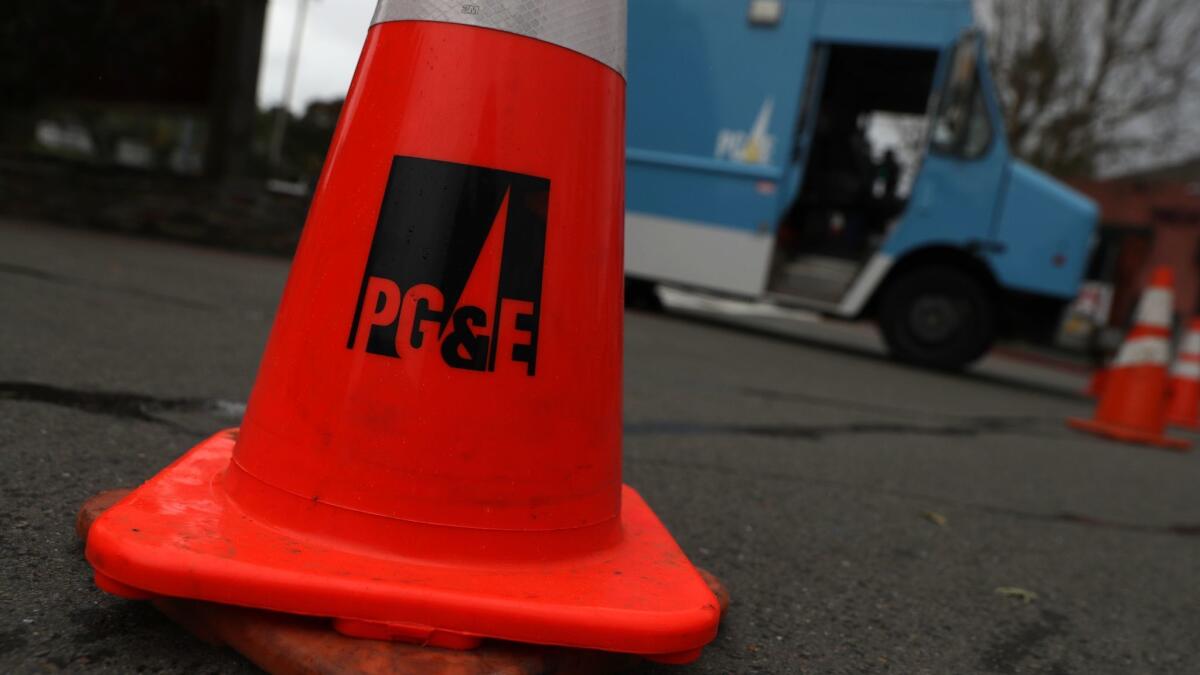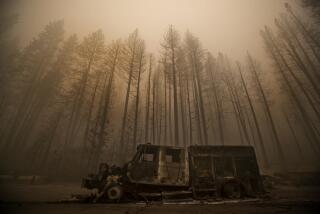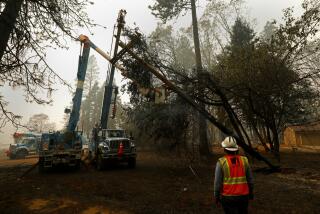Californians want to end PG&E’s operations as they exist now, new poll says

After years of deadly wildfires and a season of sweeping blackouts, a new poll of California voters finds most would impose major changes to the operations and control of Pacific Gas & Electric, a company beleaguered by sharp criticism and struggling to dig out of financial troubles.
A UC Berkeley Institute of Governmental Studies poll conducted for the Los Angeles Times asked likely voters to choose the best path forward for PG&E, which filed for bankruptcy this year, citing the potential for $30 billion in liabilities from wildfires sparked by its equipment in 2017 and 2018.
Fewer than 1 in 8 likely voters surveyed want PG&E to fix its own problems and maintain its current structure once it emerges from bankruptcy next year. Voters were surveyed last month — in the middle of wildfire season — and after PG&E had begun historic blackouts, intentionally leaving millions of customers in the dark to mitigate the risk of the company’s equipment starting blazes.
“Californians are reading reports from the PG&E chairman and CEO that we’re going to be in this boat for the next 10 years and it’s going to take massive investments to make this safer,” said Mark DiCamillo, the director of the Berkeley IGS poll. “Should we just allow PG&E to continue making the decisions about the best way out of it? I think the public in that respect is just saying no.”
But voters provided no clear support for any single path forward, with 35% saying they would allow PG&E to remain an investor-owned utility and 37% supporting government-run models. Roughly 28% offered no opinion at all.
About 14% of likely voters endorsed splitting PG&E’s gas and electricity divisions into two separate companies that would remain investor-owned and regulated by the California Public Utilities Commission. Selling PG&E to another utility company was supported by 9%.
Roughly 17% of the survey’s participants said that PG&E should be converted into a state-run agency, with government officials responsible for fixing its problems in the future. One-fifth of those polled want to divide the company into smaller, non-profit city and county cooperatives.
“This is exactly what you’d get from the Legislature — a mixed-bag of solutions,” said state Sen. Jerry Hill (D-San Mateo), a PG&E critic since the 2010 San Bruno pipeline explosion killed eight people in his district. “Everyone wants to see something different, but when it gets down to what that different is, it’s a scary proposition because so much hinges on it. I don’t think anyone has the magic formula because frankly, we don’t know enough.”
Under mounting political pressure, California leaders have pondered various options for PG&E’s future during the last year. Legislators passed Assembly Bill 1054 over the summer, requiring any utility that emerges from bankruptcy to settle wildfire claims and earn a safety certification in order to access a multibillion-dollar fund to pay wildfire liabilities. The legislation also gave the California Public Utilities Commission final say over the resolution of the bankruptcy case.
But with the clock ticking for the PG&E bankruptcy to wrap up by July, the road ahead for the state’s largest utility remains unclear.
PG&E announced a $13.5-billion settlement with wildfire victims on Friday, marking major progress toward resolving its liability for some of the worst blazes in state history, including the 2018 Camp fire, which investigators say was caused by the company’s poorly maintained equipment. The Butte County blaze killed 86 people and destroyed more than 13,900 homes.
The company says the agreement, in addition to previous settlements of $1 billion with cities and counties and $11 billion with insurance companies, leaves PG&E poised to satisfy its requirement to settle all wildfire claims under state law and remain on track to exit bankruptcy on time.
Gov. Gavin Newsom has until Friday to weigh in on the settlement, a key moment in the bankruptcy process.
The governor last month convened a task force led by Cabinet Secretary Ana Matosantos to develop an alternative option to restructuring the utility that the administration could pursue if the plans devised in bankruptcy court conflict with AB 1054 or do not support the state meeting its clean energy goals.
At the time, Newsom said the task force would explore a structure similar to that of the California Independent System Operator, the nonprofit public benefit corporation that runs much of the state’s electric grid. The governor appoints five members who serve staggered terms on the CAISO board of governors and oversee budgets, policies and grid planning.
Another emerging model, championed by San Jose Mayor Sam Liccardo and a coalition of more than 100 mayors and local elected officials, would turn PG&E into a customer-owned utility — a concept different from the options outlined in the poll. A customer-owned utility would operate without paying dividends to shareholders and is exempt from federal taxation, thus saving ratepayers billions of dollars over the next decade, Liccardo said.
Liccardo said his coalition is waiting for Newsom to respond to the settlement PG&E struck with wildfire victims before formally introducing its plan and finalizing investments to fund a takeover of the utility, which he expects to cost between $50 billion and $60 billion.
“As you can imagine, the financial institutions are not going to put themselves out there for a proposal unless there’s a political path for them to be implemented,” Liccardo said. “It’s a lot of work and some are doing the due diligence now. They are going to invest themselves if the governor is willing to look at it.”
As the bankruptcy process plays out, lawmakers expect to take up legislation related to utility power shut-offs when they reconvene in Sacramento next month. Liccardo and others have called for the state to have more control over the decision to turn off power during extreme weather conditions, a sentiment strongly backed by voters. Almost three-quarters of those surveyed in the poll said the decision to cut power should be shared by the utility companies and state regulators. Utility companies currently have sole discretion for when to turn off the power.
More to Read
Start your day right
Sign up for Essential California for news, features and recommendations from the L.A. Times and beyond in your inbox six days a week.
You may occasionally receive promotional content from the Los Angeles Times.







